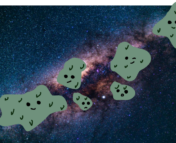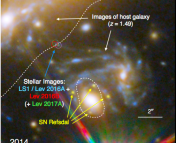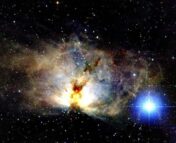Authors: Yarno Merckx, Pablo Correa, Krijn D. de Vries, Kumiko Kotera, George C. Privon, Nick van Eijndhoven
First Author’s Institution: Vrije Universiteit Brussel, Dienst ELEM, Pleinlaan 2, 1050 Brussels, Belgium
Status: Published in PRD [closed access]
This bite was written and published as part of Astrobites’s new partnership with the American Physical Society (APS). As part of this partnership, we cover selected articles from the Physical Review Journals, APS’s premier publications covering all aspects of physics. For more coverage as part of this partnership, see our other PRJ posts.
Two Competitors Enter a Notoriously Difficult Game
Imagine you show up to a soccer game blindfolded. After some time, you hear loud cheers from the crowd – one of the teams scored! But which team was it? This is kind of what it’s like deciphering where neutrinos come from. Neutrinos are some of the most difficult particles to detect because, unlike light, they don’t interact much with their surroundings. In 2013, the IceCube Observatory finally detected these elusive particles using a giant 1 km3 chunk of ice in Antarctica as a detector (you could fit almost 1,000 Empire State Buildings in this volume!). But, despite this monumental feat and continued efforts to detect more neutrinos, their astrophysical origin is still uncertain. So who are the goal scorers?
To answer this question, we first need to discuss the teams at play in this game. Neutrinos are created when a cosmic ray interacts with interstellar material. Cosmic rays are energetic charged particles, like a proton or atomic nucleus moving at near the speed of light (see Figure 1). Despite being discovered in 1925, we still don’t understand how cosmic rays are accelerated to such high energies, primarily because we can’t actually disentangle where they are coming from. Since they are charged, they are deflected by magnetic fields before reaching Earth, making it difficult to pinpoint the direction from which they originated. Two particularly extreme environments where this acceleration may occur is in the shocks produced by the explosion of massive stars (i.e. supernovae) and in the accretion of matter onto supermassive black holes (i.e. AGN). Although there are other potential places where neutrinos could be produced, these are perhaps the most promising and thus the players in today’s game.

Scoring GOALS
Now that we have the players, let’s discuss the venue for this game. One promising place for neutrino emission is in a type of galaxy called a Luminous Infrared Galaxy (LIRG, for short). LIRGs are home to large amounts of dust and gas in their nucleus, likely due to recent mergers of galaxies. This can lead to an elevated rate of star formation, which is often called a starburst. Increased amounts of star formation lead to many more massive stars that can explode in supernovae, and therefore this naturally leads to an increased rate of supernovae in LIRGs. Thus, if supernovae are producing most of the neutrinos we see, then we should see an excess of neutrinos in LIRGs! In today’s paper, the authors investigate whether starbursts in LIRGs can produce the observed neutrino flux seen by IceCube. To do this, they use data from the Great Observatories All-Sky LIRG Survey (GOALS), which combines data from numerous telescopes at different wavelengths, including Spitzer (infrared), Hubble (optical), GALEX (ultraviolet), and Chandra (X-ray).
The authors primarily focused on one of the two players in the game – supernovae. They constructed a model to investigate whether starbursts (and increased supernova rates) in LIRGs could account for the neutrino flux seen by IceCube. The model predicts the neutrino flux from supernovae and depends primarily on the rate of supernovae and how the cosmic rays are accelerated. To apply this model to the GOALS galaxies, they computed the expected rate of supernovae using the observed infrared luminosity. However, both star formation and accretion (i.e. from an AGN) contribute to the observed infrared luminosity, and only spectroscopy can effectively tell these two components apart. Using archival infrared spectra, the authors corrected the observed infrared luminosity for the effects of AGN so that it can be properly attributed to star formation.
In a Triumphant Effort, Starbursts Fall Short
With their model ready and supernova rates computed, the authors computed the neutrino flux we would expect to see from star formation alone in these LIRGs. Figure 2 shows the expected flux from the starbursts in each of the GOALS galaxies; all fall below the IceCube detection threshold! This means that starbursts in individual LIRGs are likely not responsible for the majority of neutrinos that are seen by IceCube.

The model the authors constructed also depends on the physics behind the acceleration of cosmic rays, and therefore they investigated how the expected neutrino flux varied for different acceleration physics. They primarily looked at how the slope of the distribution of momentum of cosmic rays (i.e. γSN in Figure 3) impacted the expected spectrum of neutrino emission (flux as a function of energy). Then, they compared the sum of the neutrino flux from every GOALS galaxy to the observed neutrino flux from IceCube. Figure 3 shows that no matter what acceleration physics their model assumes, the models again fall short of the observed spectrum, indicating that the diffuse neutrino flux across the sky is probably not the result of starburst emission from LIRGs.

Upcoming Rematch?
So starbursts and supernovae lost this game, but are they doomed in the future? Absolutely not! The authors highlight that there could be more contribution from more distant LIRGs than they’ve accounted for. However, there is no simple way to extrapolate this work to further distances because the evolution of LIRGs is rather uncertain. Future observations and work on LIRGs are necessary! On the neutrino side, the next generation of neutrino observatories, including IceCube-Gen2, will be more sensitive and could be able to detect the neutrino fluxes predicted by the authors’ model! So look out for a rematch coming soon!
Astrobite edited by Junellie Gonzalez Quiles
Featured image credit: Modified from NASA/CXO/SAO and Andrew Patrick




